Special Transport: A Comprehensive Guide
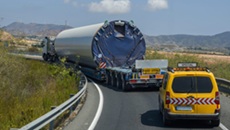 Special transport, also known as oversized or heavy transport, refers to the movement of loads that exceed standard dimensions or weight limits set by road authorities. This includes items like construction equipment, wind turbine blades, large machinery, and prefabricated structures. Given Europe’s diverse infrastructure and regulatory landscape, managing special transport requires meticulous planning, specialized equipment, and strict compliance with national and cross-border regulations. This article provides an in-depth look at special transport in Europe, including its challenges, regulatory framework, and best practices for effective execution.
Special transport, also known as oversized or heavy transport, refers to the movement of loads that exceed standard dimensions or weight limits set by road authorities. This includes items like construction equipment, wind turbine blades, large machinery, and prefabricated structures. Given Europe’s diverse infrastructure and regulatory landscape, managing special transport requires meticulous planning, specialized equipment, and strict compliance with national and cross-border regulations. This article provides an in-depth look at special transport in Europe, including its challenges, regulatory framework, and best practices for effective execution.
What Is Special Transport?
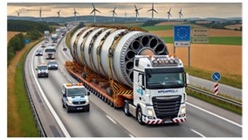 Special transport involves moving goods that cannot fit into conventional vehicles due to their size or weight. Common examples include: Industrial machinery and components. Construction and mining equipment. Wind turbine blades and parts for renewable energy projects. Prefabricated buildings or structures. Large vehicles like trains, boats, or airplanes. In Europe, it may be referred to as special transport or heavy and oversized transportation.
Special transport involves moving goods that cannot fit into conventional vehicles due to their size or weight. Common examples include: Industrial machinery and components. Construction and mining equipment. Wind turbine blades and parts for renewable energy projects. Prefabricated buildings or structures. Large vehicles like trains, boats, or airplanes. In Europe, it may be referred to as special transport or heavy and oversized transportation.
Challenges in Special Transport
- Logistical Complexity
- Planning routes that accommodate oversized loads requires analyzing road widths, bridge clearances, and tunnel heights. Ensuring minimal disruption to traffic is crucial, especially in urban areas.
- Specialized Equipment
- Requires specialized trailers, such as extendable or modular trailers, and lifting equipment like cranes. Ensuring vehicle compatibility with the load to maintain stability and safety
- Regulatory Compliance
- Varying rules across European countries for permits, escort requirements, and operational hours. Navigating customs and documentation for cross-border shipments.
- Environmental and Social Factors
- Environmental impact considerations, especially for projects in sensitive areas. Managing public awareness and minimizing inconvenience to communities.
Regulatory Framework for Special Transport in Europe
- National Regulations
- Each country in Europe has specific rules governing special transport, including: Maximum dimensions and weights allowed without a special permit. Requirements for pilot or escort vehicles. Restrictions on operating during peak traffic hours or certain days.
- EU Directives
- The European Union has established general guidelines to harmonize special transport practices across member states: Standardized processes for obtaining cross-border permits. Common safety requirements for vehicles and escort arrangements. European Best Practice Guidelines for Abnormal Road Transports
- Permits and Approvals
- Single Trip Permits: For transporting a specific load on a particular route. Annual Permits: For companies with frequent special transport needs. Applications often require details about the load, route, and vehicle specifications. Oversize and heavy loads need permits.
Key Players in Special Transport in Europe
Several specialized logistics companies in Europe excel in managing special transport. These companies leverage cutting-edge technology, experienced teams, and extensive networks to execute complex transport projects:
- Mammoet:
-
 Known for handling heavy lifting and oversized transportation projects globally. Solutions for any Heavy lifting or Transport challenge
Known for handling heavy lifting and oversized transportation projects globally. Solutions for any Heavy lifting or Transport challenge
- Fagioli:
-
 An Italian company specializing in heavy haulage and engineered transport solutions. The companies in the group are specialized in the transport, lifting and handling of major heavy items.
An Italian company specializing in heavy haulage and engineered transport solutions. The companies in the group are specialized in the transport, lifting and handling of major heavy items.
- Sarens:
-
 A Belgian company renowned for its expertise in crane rental and oversized logistics. Nothing too Heavy, Nothing too High
A Belgian company renowned for its expertise in crane rental and oversized logistics. Nothing too Heavy, Nothing too High
- Van der Vlist:
-
 A Dutch logistics provider offering tailored solutions for heavy and abnormal loads. Driven by a passion for transport and technique.
A Dutch logistics provider offering tailored solutions for heavy and abnormal loads. Driven by a passion for transport and technique.
Best Practices for Special Transport
- Planning and Route Optimization
- Conduct detailed surveys of the route, identifying obstacles like low bridges, narrow roads, and weight-restricted areas. Use GPS and route-mapping software to ensure efficient and safe travel.
- Coordination and Communication
- Work closely with authorities for permits, road closures, and escort vehicle arrangements. Maintain clear communication with stakeholders, including clients, drivers, and public agencies.
- Safety Measures
- Ensure vehicles and equipment meet all safety standards. Train drivers and operators on handling oversized loads. Use pilot cars or escort vehicles to warn other road users.
- Environmental Considerations
- Plan routes that minimize environmental disruption. Use eco-friendly vehicles and technologies where possible.
Case Studies of Special Transport Projects in Europe
- Wind Turbine Components in Scandinavia
-
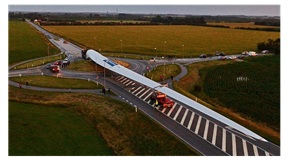 Transporting wind turbine blades over 70 meters long through narrow Scandinavian roads required: Specialized extendable trailers. Coordination with local authorities to temporarily remove road signs and barriers. The blade measures 88.4 meters in length, with a height of 4.47 meters when loaded on the truck. Precise planning was essential to this operation as the clearance to pass under bridges measured just three centimeters.
Transporting wind turbine blades over 70 meters long through narrow Scandinavian roads required: Specialized extendable trailers. Coordination with local authorities to temporarily remove road signs and barriers. The blade measures 88.4 meters in length, with a height of 4.47 meters when loaded on the truck. Precise planning was essential to this operation as the clearance to pass under bridges measured just three centimeters.
- Bridge Sections in Germany
-
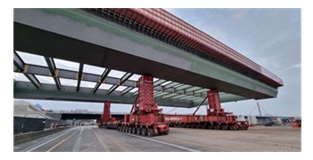 Large prefabricated bridge sections were moved to a construction site using modular trailers and barges to navigate rivers, reducing road traffic impact. SEH Engineering contracted Mammoet to move a new bridge section of the Rhine Bridge, in Leverkusen in Germany, 300 metres to its installation position.
Large prefabricated bridge sections were moved to a construction site using modular trailers and barges to navigate rivers, reducing road traffic impact. SEH Engineering contracted Mammoet to move a new bridge section of the Rhine Bridge, in Leverkusen in Germany, 300 metres to its installation position.
- Historical Artifacts in France
-
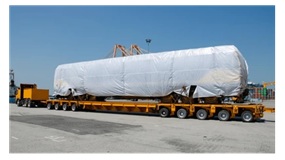 Special transport was used to move delicate and oversized artifacts to museums, requiring climate-controlled vehicles and expert handling.
Special transport was used to move delicate and oversized artifacts to museums, requiring climate-controlled vehicles and expert handling.
Future Trends in Special Transport
- Technological Advancements
- Telematics and IoT: Real-time tracking and monitoring of vehicles and loads. Autonomous Vehicles: Potential use of driverless technology for safer transport. AI-Driven Route Planning: Enhanced efficiency in selecting optimal routes.
- Sustainability Efforts
- Transition to electric or hydrogen-powered vehicles for oversized transport. Emphasis on reducing emissions and adopting greener practices.
- Harmonization of Regulations
- Continued efforts by the EU to standardize special transport rules across member states, making cross-border operations smoother.
Conclusion
Special transport is a vital component of Europe’s logistics and infrastructure sectors, enabling the movement of oversized and heavy goods critical to various industries. While challenging, advancements in technology, increased collaboration, and a focus on sustainability are transforming the way special transport is managed. By adhering to best practices and embracing innovation, companies involved in special transport can navigate the complexities of Europe’s regulatory landscape and deliver efficient, safe, and environmentally conscious solutions.
eXus Dev